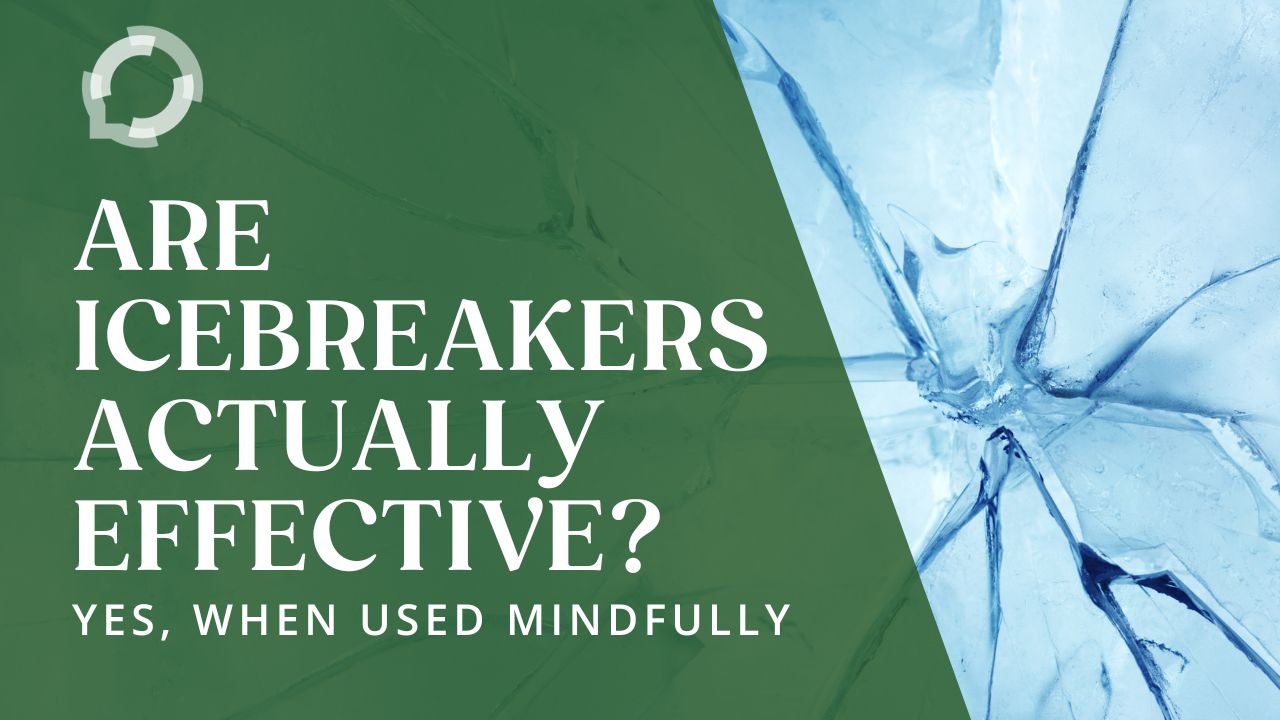“Okay, everyone. As we get started, let’s get to know each other! Turn to the person sitting beside you and find 3 things you have in common!”
If you’re like me, you’ve been in this scene time and again. Icebreakers are supposed to be fun, lighthearted conversations or games to get people talking at the start of a meeting. By giving people a shared experience, the thinking goes, they’ll be more likely to bond and get more from the overall presentation or training session.
Oh, icebreakers bring people together all right, together in near-universal loathing for this hackneyed activity.
But why? How did something intended to build community end up spawning such epic eye rolls, so many whispered snarky comments?
The key to successful icebreakers, it turns out, is the same as the key to successful public speaking and presenting: put your audience’s needs first.
The Science Behind Icebreakers
Multiple research studies by Dr. Arthur Aron and his teams have shown that strangers can develop feelings of closeness in a relatively short time span by sharing specific kinds of personal information.
In 1997, Dr. Aron and one group of researchers published their findings based on experiments designed to produce closeness in a lab setting (364). As Dr. Aron notes, the study was not intended to lead to ongoing relationships, but rather, they sought to generate a feeling related to their previous work in which had defined closeness as “‘including the other in the self’–an interconnectedness of self and other” (ibid).
Dr. Aron developed a questionnaire, included as the Appendix to the 1997 article, for pairs of participants to use, leading to “sustained, escalating, reciprocal, personalistic self-disclosure” (ibid). The questionnaire is in 3 sections, with each set of questions becoming more personal. This sequence builds trust through shared vulnerability and exchanging meaningful information.
Tara Parker-Pope notes in an article for The New York Times that Dr. Aron’s questionnaire has been popularized as the “36 questions that lead to love,” though its purpose is to foster closeness between any two people, not only lovers or would-be lovers.
In a more recent study, Fraley and Dr. Aron examined the effect of humor on closeness between strangers. They find that humor does increase feelings of closeness, “at least partially due to the extent to which the shared humorous experience creates self-expansion [that is, a new perspective on the situation] and distraction from the discomfort of the initial encounter” (73). In other words, shared humor brings strangers together at least in part because of humor’s power to reveal something new about ourselves TO ourselves and to distract from awkwardness or other unpleasant feelings.
As Fraley and Dr. Aron conclude their article, “humor plays a powerful, even seemingly magical, role in social interaction” (77). Laughing together is another way that strangers get to know each other, by understanding what each finds funny.
So What Goes Wrong?
Since the fundamental psychology of icebreakers is solid, why do they fail so often? Why is there so much resistance to them, even as internet search results for the term “icebreakers” returns pages and pages of lists with titles like “31 Unique Icebreaker Ideas!,” “59 Ice Breaker Games [That Your Team Won’t Find Cheesy],” and “170+ Fun Icebreaker Games and Activities Your Team Will Enjoy in 2023”? The increasing number of tips and escalating insistence on enjoyment suggest that there’s a great deal of pressure to get it right with icebreakers.
Icebreakers fail when they’re generic or ask participants to share trivial information that’s easily forgotten. Without relevant context to the meeting or training session, icebreakers can feel like a waste of valuable time. Forced camaraderie builds up rather than breaks down walls, as participants emotionally withdraw.
This can be especially true for icebreaker activities with teams that have already worked together for a long time, or at the start of workshops or training sessions that don’t go on to involve participants in conversations with each other. In the first situation, participants likely already know – or simply aren’t interested in – trivial details about each other. In the second, getting to know each other a little bit seems pointless if you’re not going to work together during the event itself.
The opposite is also true, though. Icebreakers that ask participants to share highly sensitive personal information, perhaps related to trauma, grief, or death, aren’t appropriate. Events, workshops, and training sessions aren’t therapy, nor are they confessionals. As Jeff Haden puts it in his article in Inc., “Asking everyone to share ‘the worst moment they’ve ever experienced,’ or ‘their most heartbreaking experience,’ or ‘their biggest failure’ goes a vulnerability bridge too far.”
Instead, he points out, “The key is to create small moments of vulnerability.”
Icebreakers Work, When Done with Intentionality
Icebreakers are the warm-up act for any participatory events. They set the tone and model how you want the audience to interact. Just as you would never have a comedian who works “blue” be the opening act for a family-friendly show, your icebreaker should lead your audience into the reason why they’re there in the first place.
So then, how can you use icebreakers successfully? Think carefully about who your audience is and what you want to achieve with your icebreaker. Pick an activity or game that’s on point for the skills or content of the main presentation or training session. Be sure to explain why you’re having the group do the activity, and give them some guidance for how to begin–the person with the shortest name goes first, etc.
Want to integrate new team members into an existing unit? Pick questions from Dr. Aron’s list of 36, or choose an activity that focuses on similarities among all participants.
Want to highlight creative thinking? Choose an icebreaker with an artistic element and encourage participants to doodle and draw.
Want to get participants in an online webinar talking so they’re comfortable speaking up later in the session and/or know where the reaction tools are? Ask a low-stakes either/or question and have participants answer in the chat, or respond to a poll, or flash certain emojis. My favorite question like this is “Is a hot dog in a bun a sandwich?” Dunkin’ or Starbucks? Sweet or savory? Anything like that will work precisely because the stakes are low but people tend to have very firm opinions about the topic.
How About You?
How do you choose an icebreaker to use with a particular workshop or training session? Do you have a few go-to favorites or do you design new activities for each audience? What are the most successful icebreakers you’ve led or participated in? Are there any icebreakers that would you never use?
What’s the silliest, low-stakes question that really gets people talking? Aside from the hot dog question, people almost always have opinions about the best type of cookie, or cake, or ice cream. Declare that white chocolate isn’t chocolate if you REALLY want folks to jump into the conversation.
Tell us about it in the comments.
Check Out Our YouTube Channel
The Rourke Training – Ongoing Mastery YouTube channel has a bit of something for everyone. Go there to get Kirsten’s take on examples of public speaking, as well as reflections on her entrepreneurial journey. The channel is also the home of the podcast Kirsten and Kellie produced for 5 years, Ongoing Mastery: Presenting & Speaking, which covers everything connected to continually improving your craft of being a public speaker, from interviews and mini-coaching sessions with guests to conversations between Kirsten and Kellie.
Come join us. Cheers, Kellie


